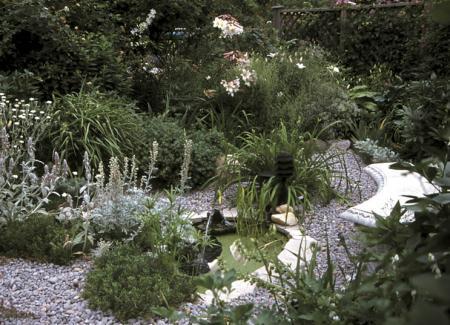By Sherry Smith
 |
Texture is generally low on the list of priorities when selecting plants for the landscape. Yet without a variety of textures in the garden, our landscapes would seem very dull.
Today's trend is toward smaller spaces. This means that the plants chosen must do double duty. They are expected to not only have attractive flowers but appealing foliage as well. Foliage that is rich in texture would be preferable so the landscape does not appear static. Contrasting plants with different textures creates interest so the eye (and subsequently, the body) moves through the garden. Texture plays an important role especially when plants are viewed up close. Some plants such as Stachys (wooly lamb's ears) are especially inviting. Their soft leaves beg us to reach out and touch them. By doing this, we become even more interactive with the garden. It's O.K. to touch the plants. It makes us feel good.
Texture contributes to the overall design and mood of the landscape. Large, coarse foliage creates a rough feeling, while finely cut leaves give a delicate, airy feeling to the garden. Take a cue from the hard landscape materials used and choose strong bold foliage to accompany rough stone walls and wooden fences. Hydrangeas, magnolias, Rhus typhina and large-leaved hostas are just a few from which to choose. Smooth flagstone surfaces lend themselves to plants with smaller leaves and a moderated outline. Use plants like Spiraea 'Snowmound', roses, Tsuga (hemlock) and perennials such as Coreopsis 'Moonbeam', geraniums and delicate poppies to create a cottage-type feel.
Texture can also be used to help create the illusion of depth and space. Just like arranging furniture in your home, if you place large bold foliage in the foreground and smaller, finer foliage to the back, a feeling of increased distance is created. Conversely, the opposite arrangement will make a garden feel smaller and closed in.
Trees and shrubs massed and viewed from a distance tend to blend and become a neutral backdrop. A hedge of spruce, cedar or hemlock will appear to have a medium texture, which makes a beautiful foil for fine- or coarse-textured plants. Smaller shrubs and perennials need this contrast to be seen and not lost within the garden. Coreopsis 'Moonbeam' is more noticeable against a solid background of yew than mixed with other fine leaved plants such as Perovskia (Russian sage) or Amsonia ciliata (bladderpod). Smaller shrubs and perennials can also play against one another. Fine leaved Cotoneaster dammeri (bearberry) beneath bold, dramatic Rhus typhina (sumac), or the classic shade combination of large, bold hostas with delicate fern fronds are just a few examples.
Texture becomes very important during the winter when there is little else in the garden. Imagine the delicate tracery of branches against a winter sky. The exfoliating bark on trees, shrubs and vines becomes even more prominent. The dark furrows in the bark of mature trees gives some relief and enjoyment for the eye from the stark whiteness and bareness of the landscape at this time of year. Grasses waving their dried inflorescenses are particularly attractive during winter. As they sway and rustle in the wind, they create movement in an otherwise static landscape. Grasses are enjoyable throughout the year. Their fine texture is particularly suitable for a lot of our modern concrete buildings. The spiky lines of grasses mimic the straight lines of modern buildings and seem to help anchor the building in the landscape. Texture is another element to consider when designing a garden. It can help to create a specific mood, and by juxtaposing fine leaved plants with coarse leaved plants, interest and movement is created. This leads to a garden that is actively enjoyed.
Some fine-textured plants
Many perennials and small shrubs feature finely dissected or small foliage. Delicate flowers will also create a finely textured look. Many of the ferns with dissected fronds and grasses can also be classified as finely textured.
| Ribes alpinum (Alpine currant) Thuja occidentalis (pyramid cedar) Buxus cvs. (boxwood) Tsuga canadensis (hemlock) Pinus strobus (Eastern white pine) Euonymus cvs. |
Salix sp. (willow) Spiraea sp. Taxus sp. (yew) Acer japonica (Japanese maple) Corydalis sp. Geranium sp. |
Coreopsis 'Moonbeam' Astilbe Dicentra formosa Artemisia sp. Gaura cvs. Perovskia |
Some coarse-textured plants
These plants usually have large, dark and sometimes dull foliage.
| Hydrangea macrophylla cvs. Hydrangea 'Annabelle' Mahonia Magnolia |
Rhus typhina (sumac) Hosta sp. Yucca Rudbeckia sp. |
Hemerocallis cvs. (daylilies) Eryngium sp. (sea holly) Kirengeshoma palmata (yellow waxbells) Rodgersia sp. |
Interesting bark
Peeling and exfoliating bark is most evident during fall and winter, and provides added texture to the winter landscape.
Betula papyrifera (paper birch)
Fagus sp.-smooth bark
Acer griseum (paperbark maple) -- interesting bark, which peels away in strips
Physocarpus opulifolius (ninebark) -- bark on older stems peels away in strips
Hydrangea anomala subsp. petiolaris (climbing hydrangea) -- very interesting exfoliating bark on older stems
Hydrangea quercifolia (oakleaf hydrangea) -- often overlooked, but has attractive exfoliating bark that is noticeable in winter
Sherry Smith is a horticulturist for JEA Perennials in Strathroy, Ontario. Previously, Ms. Smith held a horticulturist position at PAO Horticultural in Milton, and gained seven years of experience as a horticulturist at a garden centre/greenhouse operation in St. Catharines, Ontario.